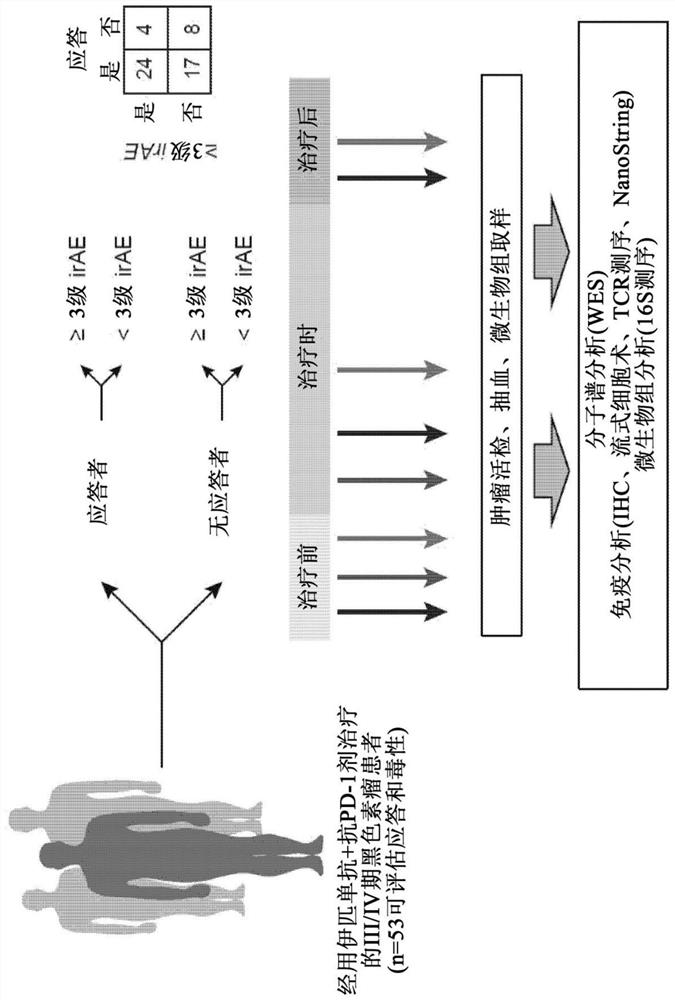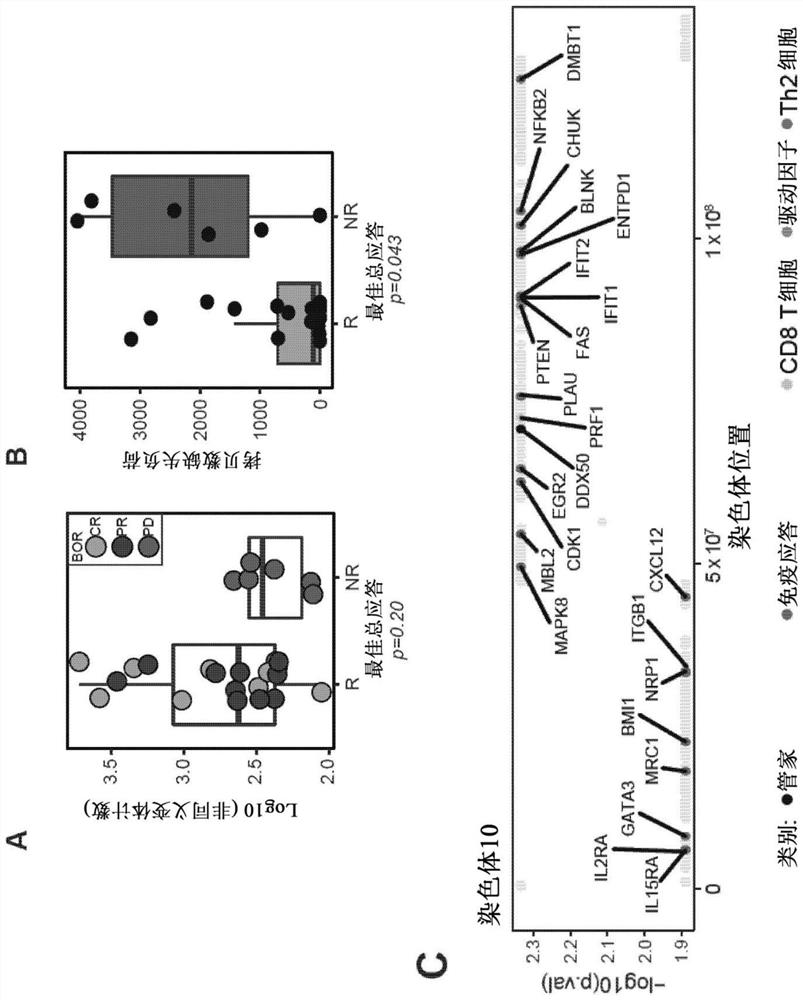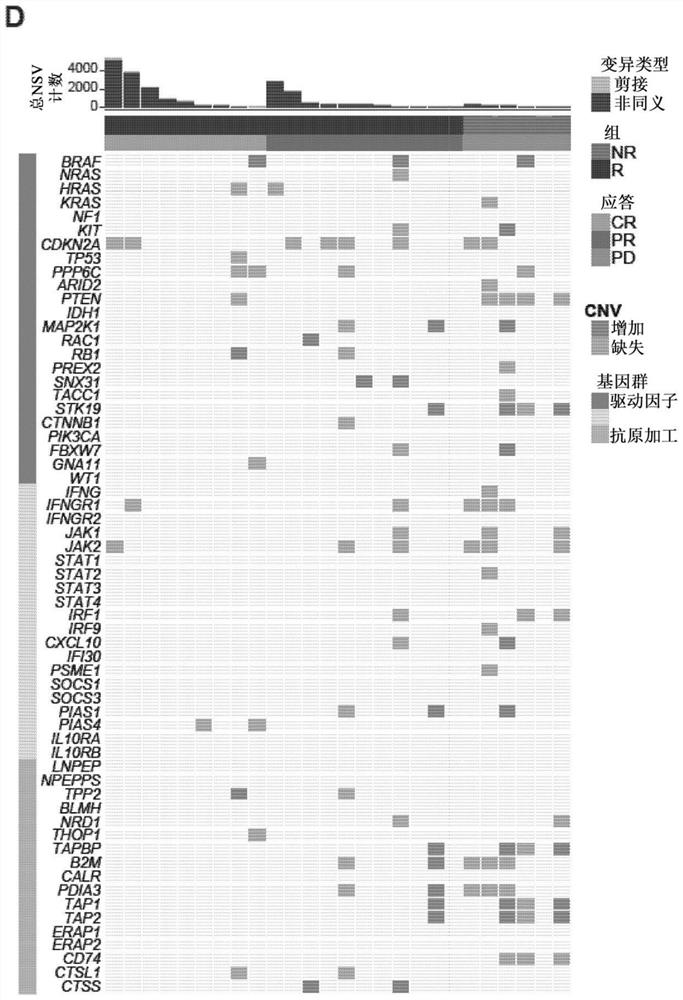Methods and compositions for treating cancer
A composition, technology of cancer, applied in the fields of molecular biology and medicine
- Summary
- Abstract
- Description
- Claims
- Application Information
AI Technical Summary
Problems solved by technology
Method used
Image
Examples
Embodiment 1
[0250] Example 1 - Molecular, immune and microbial factors in response and toxicity to combined CTLA-4 and PD-1 blockade
[0251] Cancer treatment paradigms are rapidly evolving, driven by parallel advances in the ability to understand and deeply characterize tumors at the genomic and immune levels. Checkpoint blockade immunotherapy targeting negative regulatory pathways that lead to ineffective antitumor immune responses in patients is now a practical and effective strategy in widespread clinical use. A variety of new agents are in development, designed to block immunosuppressive or activate immunostimulatory molecular targets. Efforts to improve response rates to checkpoint blockade are currently dominated by combination drug strategies, exemplified by the combination of CTLA-4 and PD-1 inhibitors (Combined Immune Checkpoint Blockade, CICB). Although more effective at inducing objective responses (Larkin et al., 2015), this combination was associated with significant immune...
Embodiment 2
[0346] Example 2: Efficacy and tolerability of combined immune checkpoint blockade in metastatic melanoma is influenced by the gut microbiome
[0347] The gut microbiome is increasingly recognized as a powerful modulator of anti-PD1-based cancer immunotherapy. Compelling evidence for differential bacterial enrichment and diversity in responders (R) versus non-responders (NR) is mediated by profound effects on systemic and antitumor immune infiltrates. However, this has not been studied in the context of treatment with combined immune checkpoint blockade (CICB), which is associated with excellent response rates but a higher incidence of potentially debilitating toxicities. Methods: The inventors recruited a cohort of metastatic melanoma patients (n=54) who were undergoing CICB. All patients were classified as R (n=31, CR+PR) or NR (n=23, SD+PD) based on RECIST v1.1 and as having grade 3 or higher according to NCI CTCAE 4.0 criteria Grade (T; n=29) or less than grade 3 (NT; n=...
Embodiment 3
[0349] Example 3: Peripheral immune repertoire and gut microbiome signatures correlate with toxicity against combined blockade of CTLA-4 and PD-1
[0350] Treatment with combined immune checkpoint blockade (CICB) targeting CTLA-4 and PD-1 is associated with clinical benefit in several tumor types, but also with a high incidence of immune-related adverse events (irAEs). A better understanding of biomarkers and mechanisms of response and toxicity against CICB is needed. To address this question, the inventors analyzed the blood, tumor, and gut microbiomes of 77 advanced melanoma patients treated with CICB, and the incidence of any grade ≥3 irAEs was high (49%). Immune and genomic biomarkers of response to CICB were similar to those identified for anti-CTLA-4 and anti-PD-1 monotherapy. Toxicity from CICB was associated with a more diverse T-cell repertoire and a less antigen-stimulated phenotype. Novel microbial determinants of toxicity against CICB, such as Bacteroidetes enter...
PUM
 Login to View More
Login to View More Abstract
Description
Claims
Application Information
 Login to View More
Login to View More - R&D
- Intellectual Property
- Life Sciences
- Materials
- Tech Scout
- Unparalleled Data Quality
- Higher Quality Content
- 60% Fewer Hallucinations
Browse by: Latest US Patents, China's latest patents, Technical Efficacy Thesaurus, Application Domain, Technology Topic, Popular Technical Reports.
© 2025 PatSnap. All rights reserved.Legal|Privacy policy|Modern Slavery Act Transparency Statement|Sitemap|About US| Contact US: help@patsnap.com



